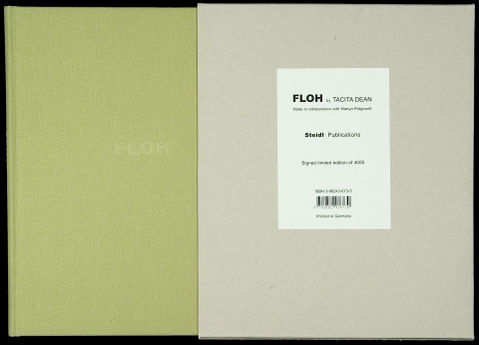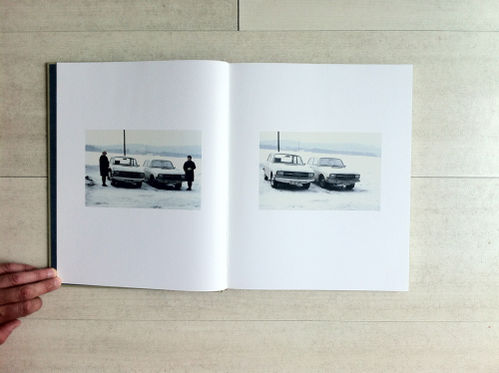Mia/History of the Photobook
1. Selection: photo books as a reference
- Tacita Dean: FLOH
- Michael Wolf: Hong Kong Trilogy
- Ed van der Elsken: Sweet life
- Hans Verschoor: Voordeuren
- Krijn Giezen: Meubels/Furniture
2. Analysis of 1 chosen photo book: Tacita Dean - FLOH
GENERAL INFROMATION :
- Hardcover: 188 pages
- Publisher: Steidl; 1st edition (3 Sept. 2001)
- Language: English
- ISBN-10: 3882436735
- ISBN-13: 978-3882436730
- Dimensions: 25.7 x 2.5 x 30.7 cm
TYPE OF BOOK : Photo book as artistic statement, conceptual
BOOK AS AN OBJECT :
Tacita Dean's book titled FLOH comes in the cardboard case of dimensions around 25x2x30 cm. The natural colour of cardboard, simple structure and visible stapling make for raw, naked design, forming a simple box with a white label on the front side. This sticker acts as a front and back at the same time, including all the information on the book: its title, author, publisher, number of copies in the limited edition (4000), ISBN number and barcode, everything on the front cover. Inside the case which is open on one side, there is a hard covered book of rather thick text block consisting of signatures sewn together. Cloth covering is in light green-grey colour, front cover being blank except for the title FLOH pressed in without ink just as a 'blind stamp’ or ‘embossing'. Very simple design has only one contrasting detail - the red headband. On covers or spine there is no other information besides the pressed word FLOH – the title. Opening the book we can see blue-grey end paper with again no information regarding the author, year or publisher. No text at all. On the first page there is artist’s signature handwritten in pencil and number of the copy out of 4000.
On the outside, the book reminds me of a family photo album with common lining as well as with blueish end-paper. The case where the book is kept in resembles the box someone’s grandparents would have to store pictures of relatives, ancestors and memories. With its simplicity, books outward appearance relates to the personal and modest. But turning the first page, we see artist’s original signature and numbering, creating a feeling of handling with precious, valuable object - an original – similar to etchings or other original prints. Inside the book there is no numbering of pages, introduction nor description, the book consists of snapshot pictures of people, holidays, instances from everyday life, portraits etc. Some pages unfold to make 3 page spread (for example the page with a man and his yellow car). The story is built on merely visual experience, absence of text allowing us to focus on the photographs and how they relate to each other.
CONTENT AND CONTEXT :
The inside therefore reveals itself as an artist book, as a catalogue of Tacita Dean’s work, or so it seems. However, we can sense certain tension between the layout that resembles classic, catalogue-like presentation of photographer’s work, while the pictures themselves do not have common aesthetics or even look like they belong to different contexts. Family snapshot is one of the most humble of photographic genres, it is ubiquitous and rarely considered art. Despite its aesthetics have been introduced in contemporary photography, merely a snapshot is not yet in the field of art. Lack of coherence between disparate images therefore triggers viewer’s interest – how are these snapshots related to each other, who are the people captured etc. The title Floh, meaning flea in German, is a hint to the concept of the book. As mentioned it was made by a British artist Tacita Dean in collaboration with Martyn Ridgewell. As a matter of fact, the artist chose images she bought in flea markets in Europe and US, namely cheap, forgotten, unimportant pictures that did not belong anywhere anymore.
Each image by itself remains silent and mysterious and its first meaning will never be known to the viewers, because it was abandoned, lost, misplaced and as such ended up on the flea market. Pictures that once embodied personal memories are detached from their origin. Inserted in a larger sequence of disparate snapshots, they become a part of different narrative. >>Dean gives them both life and potential narrative – discreet and enigmatic, but a narrative that speaks of memory, desire, loss, hope, redemption, truth, fiction.<<
OPINION :
Even though Tacita Dean is not the only artist who made a book with vernacular photographs (postcards, studio portraits), I chose FLOH because it has more of a conceptual background and is blurring the line between everyday life and art. I think it is an interesting idea to make a photobook – an artist book – of found pictures of unknown authorship, origin and low artistic merit and thus turn them into a new whole. I like that besides artist’s curatorial intervention, interpretation of the book depends largely on the imagination of the reader (viewer). Thus he can make up stories about enigmatic disparate pictures, trying to find their relations. I chose this work because I wanted to show how an original book can be an artwork and a statement, despite (or because of) being made with found pictures or works of others. With this work I sensed how can such ordinary, insignificant documents become a part of a very precious object, signed by the artist.


